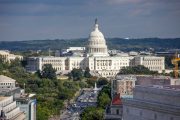
Political organizations and advocacy groups around the country are curtailing or canceling their planned activities and advertisements in the wake of the shooting of Representative Gabrielle Giffords and the killing of six people at an event in Tucson, Arizona, last Saturday.
Various outlets are reporting that the political atmosphere is inhospitable to such overt political behavior and unseemly in light of the events in Tucson.
For example, in North Dakota, the Iowa-based political action committee American Future Fund, has shelved the series of ads it produced critical of Democratic Senator Kent Conrad. The group indicated that it was taking this tack out of respect to whats going on in Arizona.
A piece published online by Roll Call reports:
Party committees are withholding e-mail campaigns going after Members [of the House of Representatives]. The Democratic Congressional Campaign Committee postponed political events, fundraisers, and e-mails related to the health care repeal bill that had been slated for a vote this week.
The National Republican Congressional Committee also is in a holding period, waiting on its work related to the repeal measure until legislative business resumes.
In a similar vein, an article published Monday in the Washington Post presented a tableau intended to lead readers to the conclusion that any political advertising would manifest a deplorable lack of decorum in the post-Tucson world. While the language used by the author is typical of the wink and nod double-speak that is the patois of the mainstream media, the underlying message is clear.
There is no conclusive connection between the motives of the alleged Tucson shooter, 22-year-old Jared Lee Loughner, and the inflamed political discourse that has become the norm in recent years. He may prove to be a deranged loner and nothing more. Still, the terrible events have brought a renewed and healthy focus on the culture of politics in this country. In the short term at least, everyone has pulled back to pause and reflect.
That paragraph is laden with weighted interlinear commentary. The so-called inflamed political discourse of which the author writes is hardly new. Hammer and tongs political combat has been commonplace since the birth of our republic. To imply that perhaps the tragedy of Tucson will alter this, or should alter this, is historically nave and a distasteful appropriation of the deaths of six people in order to add flourish to the authors journalistic style.
Of course, as the political atmosphere changes, so must the behavior. No longer, the article insists, will politicians be willing to risk their lives in order to interact with constituents. The iconic image of the threat faced by politicians as described by the Post approaches melodrama.
The presidential motorcade complete with flashing lights, armored limousines, heavily armed war wagons and Secret Service agents at the ready is an iconic image of modern politics in the United States. That is the exception. The norm is what was taking place in Tucson on Saturday: a lone politician, without security, accompanied by a few members of her staff, making herself available to the public and paying a huge price.
Evocative imagery to be sure, but demonstrably inaccurate. The critical wounding of Representative Giffords is disturbing and all compassionate citizens should afford the requisite and appropriate concern. That said, however, the notion that the usual scene at political rallies is congressmen dodging bullets is ridiculous. The number of American elected officials who have been killed while performing their official duties can be counted on one hand. In fact, only 10 congressmen have been killed while in office. Of that number, Congressman Leo Ryan was the only one ever to be killed in the line of duty. He was murdered during a visit to Jonestown, the cult village headed by Jim Jones, just before the Jonestown massacre.
The distortion continues with such hyperbole as to incite doubt as to the authors sincerity.
The rest [of politicians] carry on their duties fully exposed to whatever fury may await them, whether rhetorical insults hurled from a crowd at a town hall meeting or the violent act of a sick individual with access to a gun.
Finally, the solution proffered by the author of the article in the Washington Post is as chilling as the rest of the piece was theatrical.
Tamping down some of the inflammatory rhetoric may not prevent future acts of violence by mentally unstable individuals. But its possible that out of what happened in Tucson there will be some positive changes, at least for a time whether that means measures to make the everyday lives of elected officials more safe, or a more sober approach to resolving legitimate differences [on] how to solve the countrys problems.
Patriots enlightened with an appreciation for the record of the fall of republics throughout history will recognize in this portrait the tint of tyranny. Free speech that is inconsistent with the party line is redefined inflammatory rhetoric and the tamping down” thereof under the boot of legislative abridgement will be praised as positive changes.”
The fostering of fear through the recasting of political opposition as the frothing ravings of madmen is deceitful and little more than the typical use of tragedy as a pretext for tyranny through the promise of safety.
Related articles:
Politicizing Ariz. Mass Shooting to Demonize Guns, Conservatives
The Shameful Manipulation of Murder: Gun Control and Tyranny
The Arizona Shooting: The Left’s Prejudice and Hypocrisy on Display

